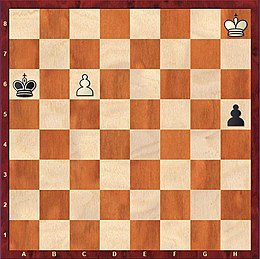منصوبة ريتي
| صنف فرعي من | |
|---|---|
| جزء من | |
| الرياضة | |
| سُمِّي باسم | |
| المُؤَلِّف | |
| تاريخ النشر | |
| له جزء أو أجزاء |

منصوبة ريتي في لعبة الشطرنج هي دراسة لوضعية في نهاية اللعب تشمل ملكاً وبيدقاً لكل طرف، قام بتركيبها اللاعب المنتمي إلى الإمبراطورية النمساوية المجرية ريتشارد ريتي والذي حمل لاحقاً الجنسية التشيكوسلوفاكية . ُنشرت المنصوبة في عام 1921 في المطبوع المهتم بنشر أخبار الشطرنج «Kagans Neueste Schachnachrichten».
توضح المنصوبة كيف يمكن لقطعة الملك أن توجه تهديدات متعددة وكيف يمكن لها أن تسلك أكثر من مسار واحد للوصول إلى موقع معين، وذلك باستخدام نفس العدد من النقلات . ذاع صيت هذه المنصوبة التي تقدم دراسة للمرحلة النهائية وتناولت العديد من الكتب حول نهاية اللعبة محور دراستها .
تعرف المنصوبة باسماء مختلفة مثل «مناورة ريتي» أو «فكرة ريتي»,[1] (Nunn 2007:118–19) وتسمى أيضا «مطاردة عصفورين في آن واحد».[2] وأطلق مؤلف التركيبات أبرام غورفيتش على المنصوبة اسم «مطاردة قواعين» . و لمنصوبة ريتي حضور في العديد من الأدوار ومنصوبات أخرى .


منصوبة أخرى بنفس الفكرة
[عدل]
استخدم ريتي نفس الفكرة في منصوبة أخرى قام بتركيبها في سنة 1928. الحل هو:
| رقم النقلة | نقلة الأبيض | نقلة الأسود |
|---|---|---|
| 1 | ♔6g | ♔ 6b |
| 2 | ♔7g | f5 |
| 3 | ♔6f! | f4 |
| 4 | ♔5e | f3 |
| 5 | ♔6d | f2 |
| 6 | c7 | f1=♕ |
| 7 | c8=♕ | ♕f4+ |
| 8 | ♔5d | ½-½ (Fishbein 1993:18–19) |
أمثلة من الأدوار
[عدل]ياتس أمام مارشال
[عدل]في هذا الدور[3] بين فريدريك ياتس وفرانك مارشال، تعادل الأسود باستخدام نفس الفكرة:
- 60... Kb2! (if 60... Kc2? 61. f4 wins)
- 61. Kxa4 (if 61. f4?? then 61... a3 wins)
- 61... Kc3!
- 62. f4 Kd4 ½-½ (Fishbein 1993:18–19), (Dvoretsky 2006:26–27)
لاسكر أمام تاراش
[عدل]In this 1914 game[4] between بطولة العالم للشطرنج إيمانويل لاسكر and زيغبرت تاراش, Black exchanged down into this position because he thought it was a win, but White used the maneuver above to draw the game.
- 40. h4 Kg4
- 41. Kg6! Threatening 42. h5 (Giddins 2007:8). Black had only considered the line: 41. Kf6? c4 42. bxc4 bxc4 43. Ke5 c3 44. bxc3 a4 45. Kd4 a3, winning (Kasparov 2003:209).
- 41... Kxh4 This move is مسرد الشطرنج and the white king gains a tempo to return on a different diagonal which is not obstructed by his pawns (Giddins 2007:8).
- 42. Kf5 Kg3
- 43. Ke4 Kf2
- 44. Kd5 Ke3
- 45. Kxc5 Kd3
- 46. Kxb5 Kc2
- 47. Kxa5 Kxb3 ½-½
The theme of this endgame was used later by Réti in the study (Kasparov 2003:210).
مراجع
[عدل]- ^ (Müller & Pajeken 2008:32–33)
- ^ (Müller & Lamprecht 2007:39).(Dvoretsky 2006:26)
- ^ Yates vs. Marshall نسخة محفوظة 03 مارس 2016 على موقع واي باك مشين.
- ^ Lasker vs. Tarrasch نسخة محفوظة 17 مارس 2017 على موقع واي باك مشين.
- de la Villa، Jesús (2008)، 100 Endgames You Must Know، New in Chess، ISBN:978-90-5691-244-4
- Dvoretsky، Mark (2006)، Dvoretsky's Endgame Manual (ط. 2nd)، Russell Enterprises، ISBN:1-888690-28-3
- Fishbein، Alexander (1993)، King and Pawn Endings، American Chess Promotions، ISBN:0-939298-39-2
- Giddins، Steve (2007)، 101 Chess Endgame Tips: Golden nuggets of endgame wisdom، Gambit Publications، ISBN:978-1-904600-66-4
- Kasparov، Garry (2003)، My Great Predecessors, part I، Everyman Chess، ISBN:1-85744-330-6
- Müller، Karsten؛ Lamprecht، Frank (2007)، Secrets of Pawn Endings، Gambit Publications، ISBN:978-1-904600-88-6
- Müller، Karsten؛ Pajeken، Wolfgang (2008)، How to Play Chess Endings، Gambit Publications، ISBN:978-1-904600-86-2
- Nunn، John (2007)، Secrets of Practical Chess (ط. 2nd)، Gambit Publications، ISBN:978-1-904600-70-1
لمزيد من القراءة
[عدل]- Fine، Reuben؛ Benko، Pal (2003)، Basic Chess Endings (ط. 2nd)، McKay، ص. 11، ISBN:0-8129-3493-8
- Flear، Glenn (2004)، Starting Out: Pawn Endgames، Everyman Chess، ص. 95، ISBN:1-85744-362-4
- Keres، Paul (1984)، Practical Chess Endings، Batsford، ص. 13–14، ISBN:0-7134-4210-7
- Müller، Karsten؛ Lamprecht، Frank (2001)، Fundamental Chess Endings، Gambit Publications، ص. 31، ISBN:1-901983-53-6
- Seirawan، Yasser (2003)، Winning Chess Endings، Everyman Chess، ص. 36–37، ISBN:1-85744-348-9
- Speelman، Jon (1981)، Endgame Preparation، Batsford، ص. 26–27، ISBN:0-7134-4000-7


